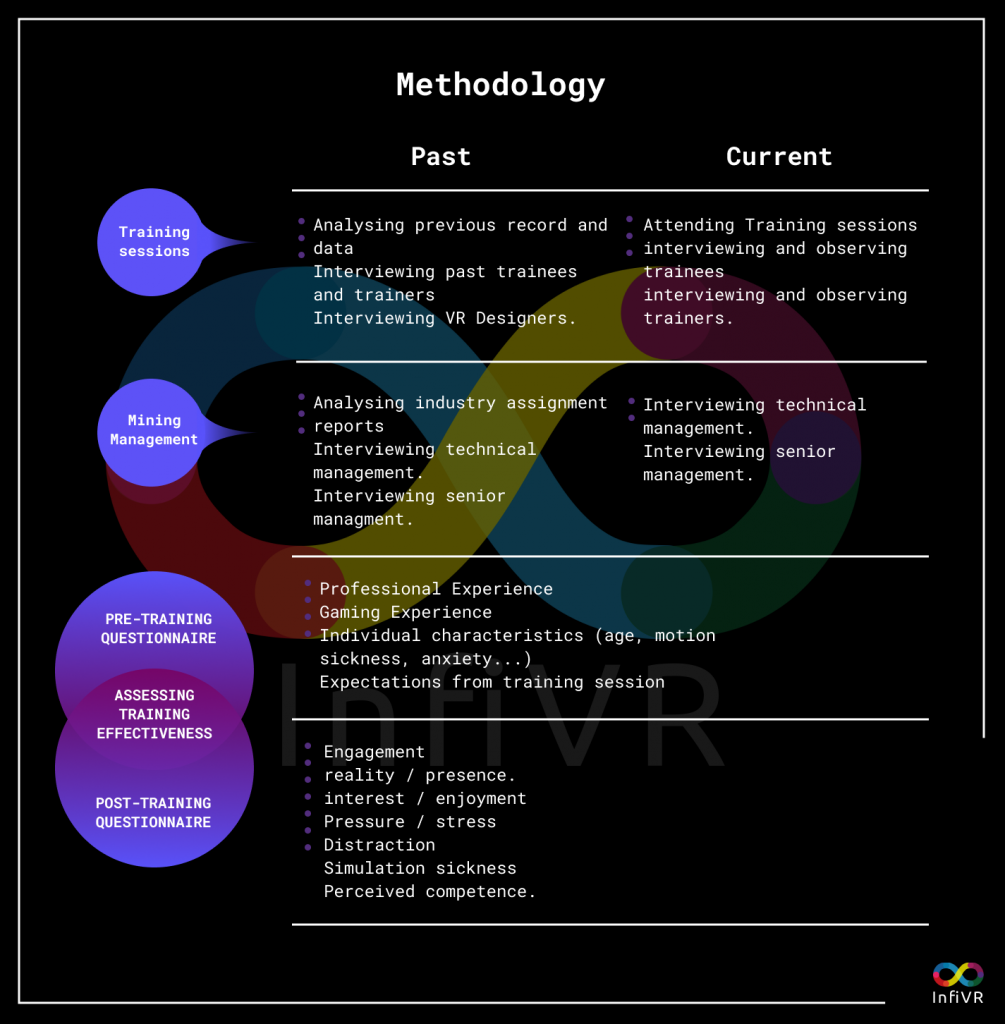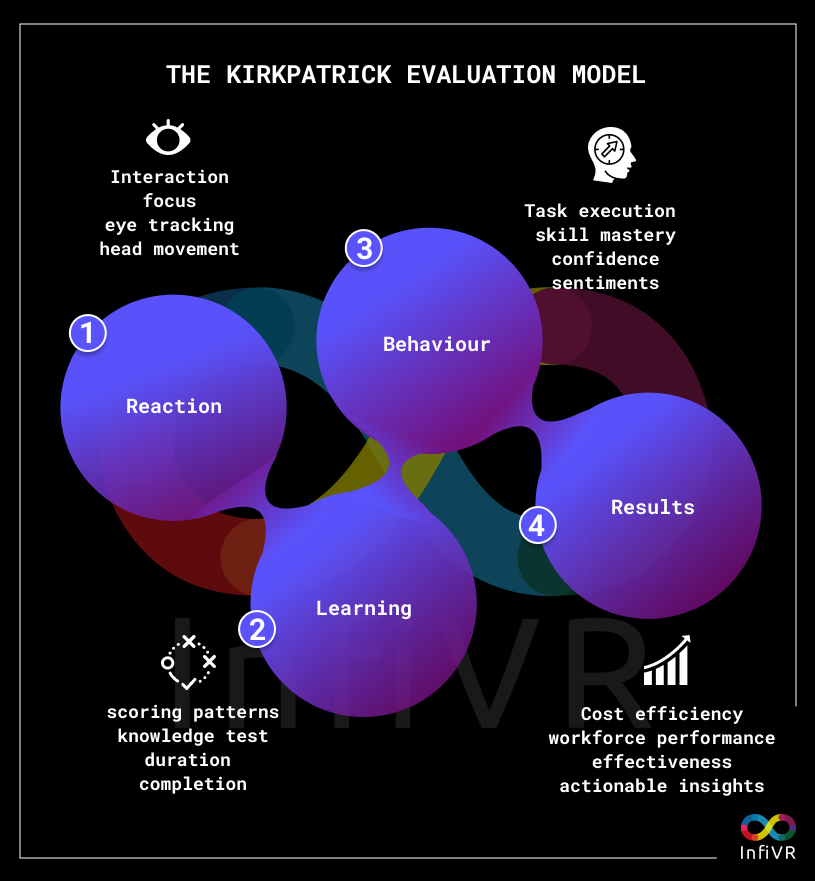How to assess the effectiveness and advantages of Virtual Reality Training POC implemented?
Assessing the effectiveness and advantages of Virtual Reality Training POC is a critical aspect of determining the success and potential impact of the VR training program within your organization. This evaluation will help you identify areas for improvement and provide insights into the overall value of the VR training initiative.
Generally, questionnaires are presented to the trainee before and after the training to evaluate the efficacy of the training. The image below provides an overview of what factors are assessed in these two stages.

Here are some guidelines to help you assess the effectiveness and advantages of your VR Training POC implementation.
1. Define Success Criteria
Before assessing the effectiveness of the VR Training POC, establish clear success criteria that align with the goals and objectives of the VR training program. These criteria should be quantifiable and measurable to facilitate an accurate evaluation. Examples of success criteria may include improved knowledge retention, reduced training time, increased employee engagement, and decreased training costs.
2. Monitor Key Metrics
Track key performance indicators (KPIs) throughout the POC implementation to measure the effectiveness of the VR training program. Examples of KPIs may include:
- Training completion rates
- Time spent on training
- Pre- and post-training assessment scores
- User feedback and satisfaction ratings
- Number of training sessions required to achieve proficiency
- Cost savings compared to traditional training methods
To assess the effectiveness and advantages of Virtual Reality Training Proof of Concept (POC), monitoring specific metrics becomes crucial. By tracking these metrics, you can gain insights into the impact of the VR training program on your organization’s performance and make data-driven decisions for future improvements.
3. Collect User Feedback
Gathering user feedback is essential for understanding the advantages and shortcomings of the VR Training POC. Conduct surveys, interviews, or focus groups with participants to gather their perspectives on the VR training experience. Ask about aspects such as user engagement, learning effectiveness, comfort, and overall satisfaction with the VR training program. This feedback will help you identify areas of improvement and understand the overall user experience.
4. Analyze Results and Compare to Baseline
After collecting data from the key metrics and user feedback, analyze the results and compare them to the baseline data gathered before the implementation of the VR Training POC. Pre- and post-training questionnaires can be employed to evaluate the efficacy of the training, assessing factors such as knowledge gain, skill development, and overall satisfaction.

Donald Kirkpatrick, a former Professor Emeritus at the University of Wisconsin, developed the Kirkpatrick Model to evaluate and analyze training and educational programs. This model comprises four fundamental steps that can be used to assess the effectiveness and advantages of Virtual Reality (VR) training implementation:
- Reaction: Gather feedback from participants to determine their response to the program, such as their level of engagement, perceived value, and any challenges they faced during the training.
- Learning: Measure the knowledge and skills that trainees have gained from the VR training program. Compare pre- and post-training assessment scores to evaluate how much the trainees have learned and retained from the program.
- Behavior: Assess whether the trainees have implemented the knowledge and skills acquired during the program in their work. Track any changes in their performance, productivity, or decision-making that can be attributed to the VR training.
- Results: Examine the benefits that your organization has gained as a result of the VR training investment, including ROI, productivity improvements, and other relevant business outcomes. This comprehensive comparison will provide insights into the effectiveness of the VR training program and help determine if it meets the defined success criteria. If the results demonstrate significant improvements in the desired outcomes, it’s an indication that the VR training program is effective.
By integrating the Kirkpatrick Model and pre- and post-training questionnaires into the assessment process, you can gain a more in-depth understanding of the effectiveness and advantages of your VR Training POC implementation. This approach enables you to make data-driven decisions about the future of your organization’s VR training program and determine if it’s worth scaling up or refining for improved efficacy.
5. Assess Return on Investment (ROI)
Calculate the ROI of the VR Training POC by comparing the costs associated with the program to the benefits and savings it delivers. Consider factors such as reduced training time, increased productivity, and decreased training costs when calculating the ROI. A positive ROI indicates that the VR training program is a worthwhile investment for your organization.
As a leader in the industry, InfiVR has worked closely with renowned organizations, providing us with valuable insights and experience. Our consultants are equipped to assist in measuring and justifying the efforts and benefits of VR training programs. We offer ROI calculators and comprehensive decks that help organizations assess the return on investment (ROI) of their VR training initiatives. By considering factors like reduced training time, increased productivity, and decreased training costs, our tools can help determine the positive impact and value of implementing a VR training program.
6. Optimizing VR Training: Assessing POC Effectiveness and Identifying Improvements
Based on the analysis of the data, identify areas where the VR Training POC can be improved. Address any challenges or issues that were encountered during the implementation, such as technical difficulties, user discomfort, or content-related concerns. Develop a plan to address these areas for improvement and refine the VR training program accordingly.
7. Share Findings with Stakeholders
Present the findings of your assessment to stakeholders within your organization, highlighting the effectiveness and advantages of the VR Training POC. Share the data and insights you’ve gathered, along with recommendations for improvement and future expansion of the VR training program. This information will help inform decision-making and support continued investment in VR training initiatives.
Explore more about Virtual Reality Training with InfiVR:
At InfiVR, we redefine industrial training with virtual reality simulation and immersive 3D gamification experience. Furthermore, InfiVR is proud partners to many Fortune 500 companies, and we’re here to transform your next-generation training visions into reality. Let’s collaborate to elevate your business by training! If you want to know more, get in touch with our consultation experts at hello@InfiVR.com.
Want to know more:
- What is Virtual Reality?
- What is Virtual Reality Training?
- What is VR Simulation?
- Advantages of Virtual Reality Training?
- Applications of Virtual Reality Training.
- Virtual Reality Maintenance Training.
- Virtual Reality Inspection Training.
- Virtual Reality Operational Training.
- Virtual Reality Assembly Training
- Virtual Reality Support & Servicing Training
- Various types of Virtual Reality Training Mediums.
- Virtual Reality based Experiential Training
- Operational Virtual Reality Training
- Virtual Reality based Behavioral Training
- Different Types of Environments in VR Training – 3D Virtual Environment.
- Mixed Reality Virtual Environment.
- Spatial Virtual Environment.
- 360* Photography-based Virtual Environment.
- VR Training in the Aviation Industry.
- VR Training in the Aerospace Industry.
- VR Training in the Defence Industry.
- VR Training in the Oil & Gas Industry.
- VRTraining in the Warehouse Industry.
- VR Training in the Manufacturing Industry.
- Hardware Selections for Virtual Reality Training
- How to adopt virtual reality training for your company?
- How to look for a suitable partner for Virtual Reality Training development?
- How to develop Virtual Reality Training POC?
- How to assess the effectiveness and advantages of Virtual Reality Training POC implemented?
- How to develop Virtual Reality Training for full-scale implementation?
- Survey forms for feedback capture on VRT
- How to successfully draft a VR training RFP?